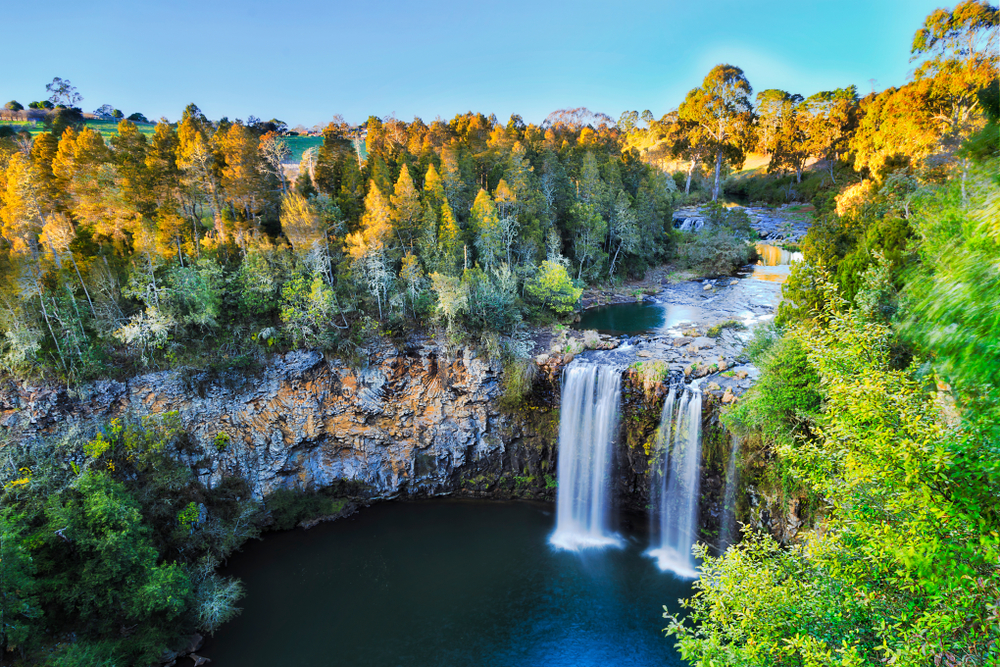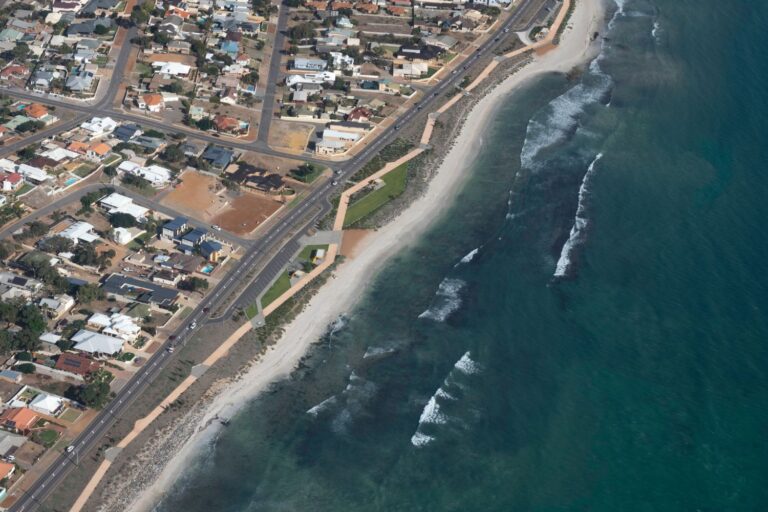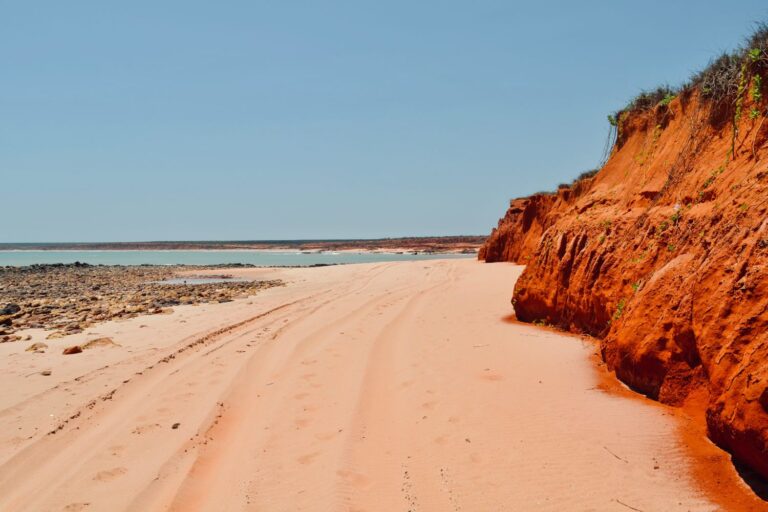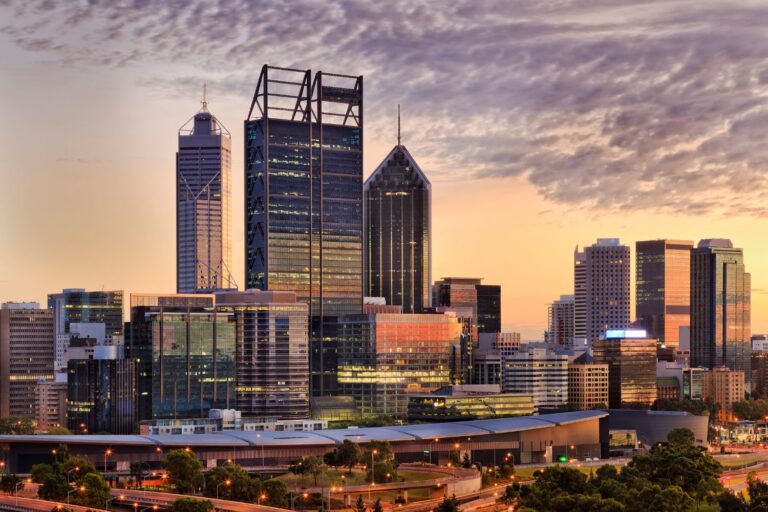Dorrigo is the gateway to one of the most beautiful rainforests on the east coast of Australia, located on the edge of the Dorrigo National Park and within an hours drive of major centres. And that was enough to have us packing the car and heading off for a few days of R&R. The day had dawned hot and steamy and the crisp mountain air of the Dorrigo Plateau beckoned. We set off along the highway with young son, Sean (… are we there yet? …) to explore the delights of the township of Dorrigo and the surrounding area. The Dorrigo Mountain Resort ([star][star][star]) boasts cabins, caravan and tents sites, and lodges but not on a large scale. It’s small, neat, and compact. We were given our choice of tent site and, surprisingly, it was a hard decision to make. All of the tent sites are lush with green grass and trees for shade and plenty of room to move. In fact, as small as it is, the whole place is well laid out and quiet and peaceful. We finally settled on a site, after changing our minds several times, and set about getting the camp organised.
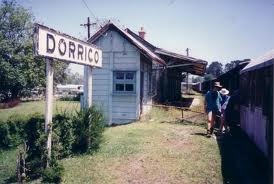
Sean had his tent up in record time (how does he do that!) and came over to give us a hand and it wasn’t long before we finished and then wandered off to have a look around. The Resort also has a playground and my 2 kids decided to check it out! But the sun was starting to go down and it was getting cool so we wandered back to camp. It was New Years Eve and we settled back with a bottle of bubbly (as you do), a wonderfully clear night with billions of stars on view, and quiet neighbours. What more could we ask?
Dorrigo is a town full of history
Dorrigo. The name has a ring to it. Although most historians agree that the first white person to see the Dorrigo Plateau was an escaped convict named Richard Craig, in the 1830’s a Major Edward Parke was exploring the tablelands of the Clarence Valley with a view to settlement when he discovered this picturesque plateau. He was a veteran of the Peninsular (Napoleonic) Wars and served under the Spanish General Don Dorrigo, a person he greatly admired. To honour his old comrade he named the eastern portion of the plateau “Dorrigo”. There is a minority belief that the name was derived from an Aboriginal word but there is no evidence to support this.
Parke established a cattle station on the plateau with Sir Maurice O’Connell who later became the Governor of Queensland. Over the next few years pioneering families began arriving and gradually the settlement grew. The rich and fertile farming land attracted many settlers and the abundant forests provided the timber industry with a variety of trees including Antarctic Beech, a timber in very short supply as it only grows above 3000 feet on the plateau. Settlement of the scrub country began in earnest in the late 1800’s. Dairy cattle were brought in and crops were planted in the rich red basalt soil. Dorrigo was on its way.
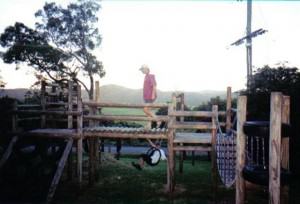
Exploring Dorrigo and Ebor
But none of that mattered to us on this lovely New Years morning. We had our usual late start but the rest of the park was much the same. Whether everyone else celebrated last night or not, I didn’t hear a thing. It was absolutely freezing during the night and, of course, it being the middle of summer, I didn’t bring a sweater. Thank goodness for John’s insistence on blankets! The amenities, I discovered, are clean if not especially modern. But the water was hot and the shower cubicle roomy. This being a public holiday we didn’t think there would be too much happening in town today so we decided to head for Ebor and the LH Dutton Trout Hatchery. Ebor is a 45-minute drive along the Waterfall Way and then another 15 kilometres (9 miles) further on is the hatchery where our first stop was to see a short film on the history of the place and what they do here.
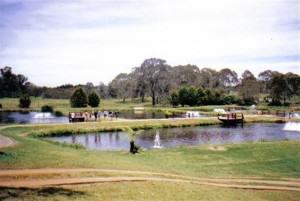
Then it was out to the actual hatchery and fish tanks. An interesting place and feeding these fish was an adventure. The fish are huge and they quite literally jump out of the water to get the food. Makes the shark from “Jaws” tame by comparison! We walked around the various ponds and tanks, feeding the fish, and learning more about trout than I’d ever wanted or cared to know. It was hot and horrendously humid and we didn’t stay too long. And, in any case, I personally think if you’ve seen one fish tank, you’ve seen them all! John and Sean were fascinated but it wasn’t to my taste.
Point Lookout in the New England National Park
After leaving the hatchery we continued up the mountain road through the New England National Park, to Point Lookout, which is 1563 metres (5127 feet) above sea level. The panoramic view was absolutely outstanding and in the distance we could see Dorrigo nestled on its plateau. A short walking track led from the parking area and went around the whole lookout. Viewing platforms were placed along the way, a hundred or so metres apart and each one offered a different view of faraway mountaintops and a never-ending panorama of awesome beauty. We could even see the Pacific Ocean, 70 kilometres (44 miles) to the east. The scenery was exceptional; the deep valleys, coastal plains in the distance, and even the Dorrigo township. It was quiet and peaceful at the lookout with birds chirping away and a soft breeze blowing and you tend to forget that in the winter there is often a dusting of snow here and many of the waterfalls freeze solid. Now that would be something to see! We returned to Ebor for lunch and our choice of what to eat was made easy by the fact that only the café in the petrol station was open.
Ebor Falls
After lunch Ebor Falls beckoned and we weren’t disappointed. What a magnificent sight. The water cascading from both the upper and lower falls was so clean and clear that it sparkled in the sunlight. We followed the path around the escarpment to get the best angle for photographs but no matter where we stood the scene was still awe-inspiring. The falls are not big, by some standards, nor could they be said to be majestic. In fact, they are quite small in comparison to others, but the sight of them flowing over rocks made smooth from eons of rushing water was fascinating. Legend says that this water has been falling since the Dreamtime, the beginning of time according to Aboriginal folklore. On the way back we decided to take what we thought was the scenic route and followed the Deervale Loop Road. Well, the tourist guides got it wrong this time. It was all a bit ordinary although some of the views were nice. But compared to what we had seen so far on this trip it was a long way down on our list of places we must return to. About the most exciting part of our drive along the Deervale Loop Road was unintentionally chasing a jackrabbit down the road.
Back in Dorrigo we paid a visit to Dorrigo Pottery where John got into a conversation with the potter (and he thinks I can talk!). But the pottery there was exquisite and, of course, all hand-made. A quick drive around the rolling stock of the proposed train museum and then it was on to Dorrigo Woodworks. Some of the furniture and carved items here are amazing. Carved out of tree stumps, branches, if it’s a tree they can make something out of it; they’re almost works of art! By the time we returned to camp we were exhausted; it was an early night for all of us but it had certainly been a good day. Cloudy and cool the next morning but it didn’t take long for the clouds to burn off and the temperature to begin its upward climb.
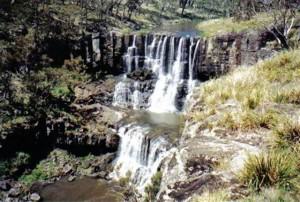
Bellingen, Craft Capital of the North Coast
After a late breakfast we headed off to Bellingen, a quaint little town on the banks of the Bellinger River. Europeans first visited the Bellinger River in 1840 and the area was opened to settlement and farming around 1860 but it wasn’t until 1887 that Bellingen was proclaimed a village. Today heritage buildings and parklands line the banks of the river giving testament to the small town’s historical origins.
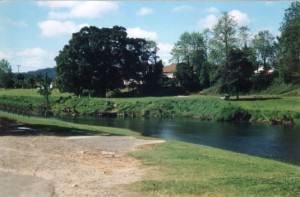
With its preponderance of art galleries, craft exhibitions, and quality giftware from leather to woodcraft to blown glass and pottery, Bellingen is hailed the arts and craft capital of the North Coast. Our first stop had to be The Old Butter Factory, an arts, craft and gift complex which began its life in 1906 as the Upper Bellingen Dairy Co-operative and today is home to one of the most brilliant collection of arts, crafts, and giftware to be found anywhere in Australia and most of it is made right there.
We quite happily filled in almost 2 hours as we walked through the galleries and exhibitions, examining the various bits and pieces, marvelling at the intricate detail of some glass etchings and hand-carved woodwork, and some of the most beautiful opals and gemstones we’d ever seen, and all the time making sure that the credit cards stayed securely locked away! It was all very tempting! In fact, it was here, in a store called The Courtyard Shoppe, that John bought me an absolutely stunning hand-blown glass egg. After leaving the Old Butter Factory we wandered up Hyde Street towards the centre of town and came to The Yellow Shed. As the name suggests, it’s just a shed and it’s painted yellow. But walk up the ramp to the front door and you are entering a world of art and craftworks from some of the most talented people on the north coast.
I was particularly taken with some Aboriginal pottery and paintings and after much umming and ahhing finally settled on a small plate with a painting of a platypus on it. But it was all so good and almost too hard to resist. John kept telling me “They don’t take American Express here!” He’s no fun, is he? We wandered through the main shopping area looking in shops and just generally taking our time; we were in no particular hurry, but Bellingen is a small town and it didn’t take us long to walk from one end to the other.
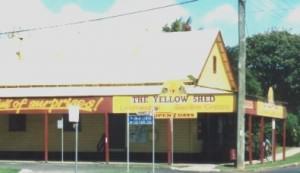
Rainforest on the Dorrigo Plateau
Soon we were headed back up the mountain and after lunch it was off to the Dorrigo Rainforest Centre, gateway to the Dorrigo National Park. The Skywalk affords some spectacular views out over the rainforest canopy and from the Rainforest Centre there are several walking tracks of varying lengths and degrees of difficulty. We wandered down the Lyrebird Link Track, which is only 400m, and it connects with Wonga Walk. Now this is 5.8 kilometres (3½ miles) long and a little too far for us this late in the day. It goes to the Glade Picnic Ground and Crystal Shower Falls and as much as we would have liked to have seen the falls we decided to walk only to the Glade, a mere 1kilometre (.6 mile), and then make our way back.
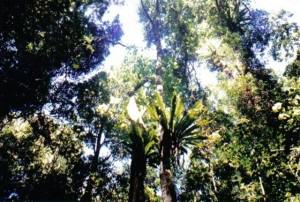
And that was more than enough for us today. But if you’re in to walking then this is a great place to do it. It would take hours, if not days, to tramp all the trails and tracks here but it would certainly be worth it. The rainforest is truly magnificent and we were amazed by the sheer size of some of the trees, not to mention the possibility of sore necks from looking up so much! We followed the well-travelled walking track through some of the most beautiful forest we’d ever seen, occasionally seeing some bush turkeys or other birds in the bush.
High in the trees there were king parrots, green catbirds, and satin birds. Most of the mammals in the area are nocturnal so we didn’t see any of them but there are also some reptiles like pythons and I’m glad we didn’t see any of them either! The track continued around through the rainforest and before too long we were in The Glade picnic area. Well laid out paths led off in different directions and we took the one that headed back to the Rainforest Centre. Not a long walk as bushwalking tracks go but enough to give us a taste of the forest. Not to mention sore feet and out of breath!
The brilliant Dangar Falls
This being our last day in Dorrigo we simply could not leave without a visit to Dangar Falls, a mere 2 kilometres (1.2 miles) north of town. Not to be confused with Dangars Falls near Armidale on the Northern Tablelands of New South Wales, Dangar Falls is not big as waterfalls go but after heavy rain the falls can be quite spectacular as the water plunges 30 metres (98 feet) over a basalt wall.
It is a popular area for picnics and there is a path that leads down to the base of the falls. It was late in the afternoon and a walk down to the base might be reasonably quick but the return climb would not. The temperature was already dropping and so we returned to camp for the evening. Another cool night and morning but the temperature climbed pretty quickly. After a leisurely breakfast we packed up the camp and left the park about 10:15. Sean wanted to stop at the Information Centre and John asked the folk there about the town where we’d planned to have our next stop. So while John chatted to them about that little no-horse town I wandered off to the Pioneer Park. I may never return to Dorrigo and I wanted to have a look at where it all started. The Pioneer Log is from a tallowwood tree and has an average diameter of 170cm (67 inches) and a volume of 20884 cubic metres (737511 cubic feet).
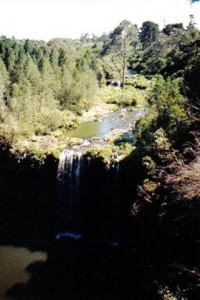
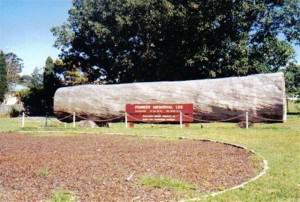
It is estimated that this was the amount of timber required to build one Australian cottage during the pioneer days. The photo does not do justice to it; it was one heck of a tree. I caught up to my boys and a little after 10:30 we left Dorrigo and headed northwest through some absolutely stunning scenery. Lush, green pastureland, spectacular hillsides dotted with trees, fat cattle, and lovely old farmhouses, over fast-flowing creeks and rivers of sparkling clear water. There’s nowhere else in the world quite as beautiful as the Australian countryside.
2004
The information contained in this journal is derived from our personal recollections of our visit to this town or region and is correct as at the time of publication. austracks accepts no responsibility should any of this information be incorrect or misleading due to changes, improvements, or upgrades that may have occurred to places and/or attractions since our visit.

